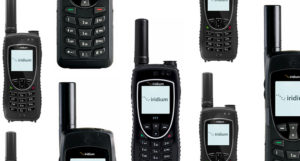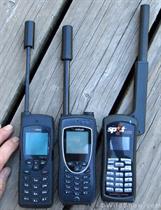We’ve never been early adopters when it comes to technology. (We only recently started using electronic charts.) However, we surprised ourselves when we recently purchased the new and comparatively untested Iridium GO! portable satellite Wi-Fi hotspot system. For the past five years of cruising aboardCeilydh, our 40ft catamaran, we’ve used a combination of an SSB, Pactor III modem and Sailmail to access weather and stay in touch while underway. The combination had its frustrations, with propagation varying dramatically depending on our location and the time of day, but on the whole it covered our needs.
However, this changed when we were planning our voyage across the Indian Ocean. While traveling in Southeast Asia we began having more and more trouble connecting to a Sailmail station. Worse yet, as we started researching the route to South Africa our concerns deepened; we discovered a significant gap in Sailmail’s SSB mid-Indian Ocean coverage and read reports of only intermittent coverage in other critical areas.
Having good communication and accurate weather reports are important anywhere in the world—but when it comes to the Indian Ocean the need turns critical. One option was to simply make do. Another was to cruise in company with boats with satellite coverage. A third option was to purchase a satellite phone—but we initially resisted this one because of both the airtime expense and the complexity of adding another system to our boat.
The Iridium GO! has been billed as a game-changing device for cruisers. It’s a new satellite phone that uses a smartphone, tablet or PC to act as the user interface to the device. It doesn’t have a keypad or a handset. What it offers is a unique and relatively simple setup, an unlimited data package and a relatively low initial cost. It also lets Facebook addicts like me stay in touch from the middle of the ocean—an unanticipated bonus I hadn’t counted on.
Once we decided we wanted the Iridium GO! we started to look for a source. Because we were having it shipped to Malaysia we opted to go with a complete package from cruiser-friendly predictwind.com. The $1,150 bundle included the Iridium GO!, an external antenna and some cabling along with an unlimited data plan for $125 per month.
Installation
Installation on our boat was simple. Because the device has built-in GPS, the first step was locating a place to mount it where the GPS had reception. Then we attached the mounting bracket to a bulkhead and powered it with a USB power cable from a 12-volt cigarette lighter plug with the included adapter. The next step was to connect it to the external antenna (the GO! has a built in antenna, but it won’t work from inside a boat). The external antenna requires a location that sees the sky with as little blockage as possible, down to 8-degrees above the horizon. In our case we just added a vertical post to our solar panel arch, keeping it low enough to avoid shading the panels and high enough to allow the antenna to see over our cabin structure.
After the hardware is in place it’s a matter of setting up your device. We installed the Iridium software on our Android smart phones and tablet from the Google Play store (Apple users need to use the Apple Store). Somewhat oddly, the GO! has two separate apps and a stripped-down web browser (XWeb for Android, Opera Mini for iOS) you need to install.
After installing the software and changing a few settings as per the instructions we were up and running. Well, mostly. We still needed to register the device with Iridium. Then we assigned a specific SOS contact person through GEOS, a third party safety service provider. It’s just a few extra steps and wasn’t complex. Once that was done we paired the phones and tablet with the GO!, which shows up as a Wifi device.
In Use
When compared to our SSB/Pactor III modem the GO! is a lot simpler to use and requires only minuscule amounts of power (0.2A). We don’t have to wait for specific times of day when propagation is best, and emails almost always go through on the first or second try. The big bonus is the GO! just gives us more options for both weather and for safety.
Weather: Our main goal with the GO! was to ensure reliable and up-to-date weather reports, and for this we’ve had a better range of alternatives than ever before. The Iridium GO! app can directly download a basic weather model, but it’s limited to your specific location. Instead we use the Iridium GO! with our PC and Sailmail’s Airmail version 3.5 to access GRIB files through email. A second program we’re using is Predict Wind’s Offshore App—this offers additional GRIB models, satellite imagery, and basic weather routing. The result has been the best weather data we’ve ever had access to—something that offers huge peace of mind as the more complex stretches of our Indian Ocean crossing approach.
Communication: The GO! has also given us more ways to communicate. Our unlimited package comes with five minutes of voice a month—something we tested briefly (it had the expected satellite phone delay) but are squirreling the rest away for either emergencies or special events. We’re also able to send free text messages and tracking information to friends and family. For email it’s not unlike using the Pactor III modem. You can send or receive emails with long body texts but large attachments either take ages to send or don’t go through at all. We’ve been sending a single compressed photo along with a blog post from our android tablet (Sailmail doesn’t permit attachments) and a single email takes 3 to 4 minutes to go through.
Internet: One of the more misunderstood aspects of the Iridium GO! is its internet access. It only has a data rate of 2.4 kbps and uses a specialized web browser so it can’t be considered a broadband internet access device, but it does offer some limited browsing capability. We’ve accessed a limited range of mobile websites including Facebook, the New York Times, BBC and CNN. Most pages take 1 to 3 minutes to load and the lost connection rate is fairly high. Currently the browser is not working with Android 5, but is working with our phone’s Android 4.3.
For us, the Iridium GO! has lived up to the hype. We have reliable and effective communication and excellent access to weather. The device does have a range of finicky bugs (in most views it chops off the first paragraph of incoming email for example) but it seems that Iridium and the third party apps have been responsive to the problems and updates regularly occur.
Article Originally posted on Sail Magazine by Diane Selkirk



